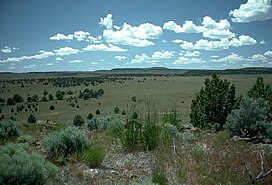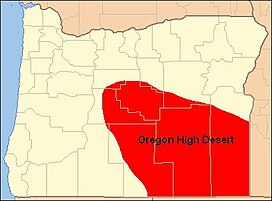| High Desert (Oregon) | |
|---|---|
| "Oregon Outback" and "Great Sandy Desert" | |
 The Oregon high desert near Frenchglen | |
 Map of Oregon's high desert region | |
| Length | 130 mi (210 km) |
| Width | 200 mi (320 km) |
| Geography | |
| Location | Oregon, United States |
| Population centers | Bend, Burns, Redmond, Lakeview, and Prineville |
| Borders on | Cascade Range (west) Blue Mountains (north) Idaho border (east) Nevada border (south) |
| Coordinates | 43°18′58″N 118°47′03″W / 43.316053°N 118.78418°W |
The Oregon High Desert is a region of the U.S. state of Oregon located east of the Cascade Range and south of the Blue Mountains, in the central and eastern parts of the state. Divided into a southern region and a northern region, the desert covers most of five Oregon counties and averages 4,000 feet (1,200 m) above sea level. The southwest region is part of the Great Basin and the southeast is the lower Owyhee River watershed. The northern region is part of the Columbia Plateau, where higher levels of rainfall allow the largest industry on private land to be the cultivation of alfalfa and hay. Public land within the region is owned primarily by the Bureau of Land Management, which manages more than 30,000 square miles (78,000 km2) including five rivers designated as Wild and Scenic.
While the high desert is somewhat dry, it is only arid relative to Western Oregon. The region averages 15 inches (380 mm) of annual rainfall; the Alvord Desert, however, receives only 7 inches (180 mm) of rain each year. Contrary to its name, most of the high desert is not dry enough to truly qualify as desert, and biologically, most of the region is classified as shrubland or steppe.
At 9,733 feet (2,967 m) above sea level, the summit of Steens Mountain is the highest point in the high desert. The broad fault-block mountain is characteristic of the basin and range plate tectonics of the high desert. About 16 million years ago, during the early Miocene epoch, lava flows from volcanic eruptions covered about half the surface area of Oregon. The Earth's crust then began stretching, giving way to further volcanic activity from 15 million to 2 million years ago. Several ice ages over this time formed the large lakes in the high desert.
The climate of the high desert provides habitat for mammals such as pronghorn, coyote, mule deer, black-tailed jackrabbit, and cougar. Birds common in the region include sage-grouse, California quail, and prairie falcon. The western juniper is the most common tree in the region, and big sagebrush and common woolly sunflower are the region's most widespread plants.